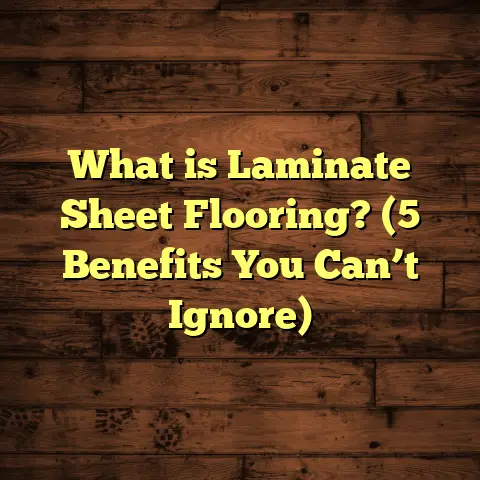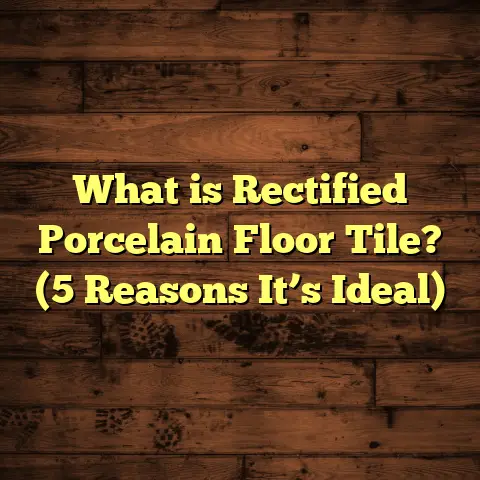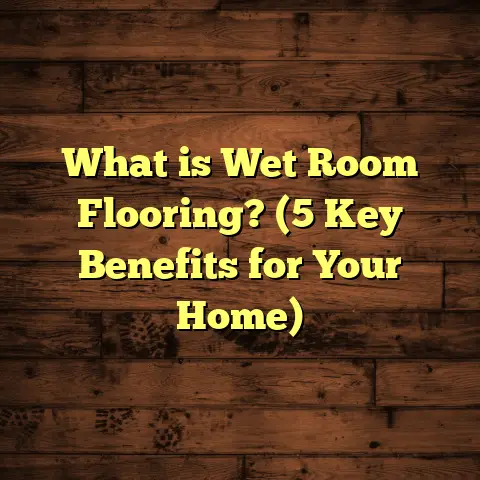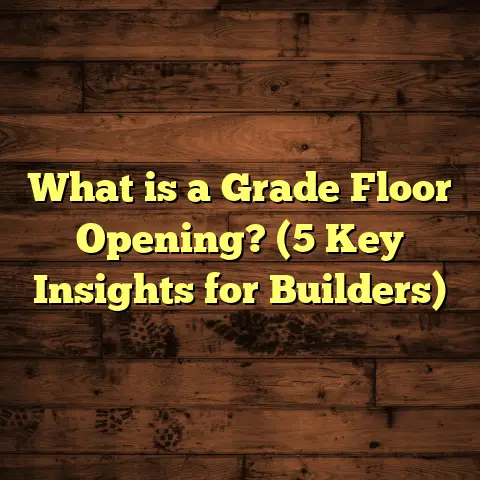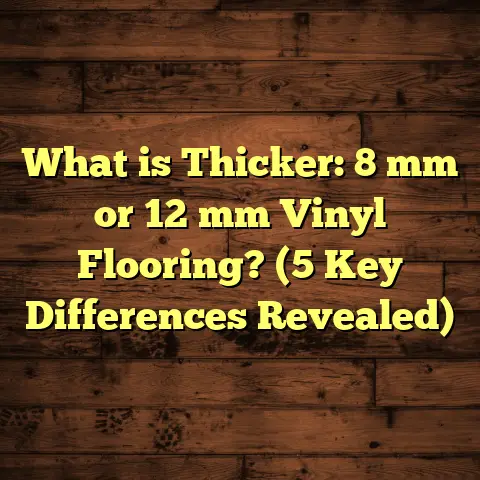What is a Poured Floor? (5 Key Benefits for Modern Homes)
I remember the first time I heard the term “poured floor,” I thought,
“Is someone pouring drinks on the floor now?” Turns out, it’s not about
cocktails or coffee spills—it’s a type of flooring that’s been quietly
transforming modern homes. And honestly, once I got the hang of it, I
realized poured floors are kind of like the superheroes of the flooring
world—strong, sleek, and pretty darn versatile. Let me walk you through
what poured floors really are and why they might just be the perfect fit
for your home.
What Is a Poured Floor?
Simply put, a poured floor is a seamless flooring surface created by pouring
a liquid material—usually concrete or epoxy resin—directly onto the
subfloor. Once it sets and hardens, it forms a solid, continuous surface
without seams or joints. This is different from traditional flooring like
tiles or wood planks that are installed piece by piece.
The magic here is in the liquid state that fills every nook and cranny before solidifying.
This results in a smooth, durable floor with a modern look. Poured floors
commonly use materials like:
- Concrete: The classic choice, often polished or stained for an industrial
or contemporary vibe. - Epoxy resin: Offers a glossy finish and vibrant colors with added chemical resistance.
- Polyurethane and other polymers: For flexibility and durability, used in specialized applications.
What makes poured floors so interesting is their versatility in design and function.
They can mimic stone, wood grain, or even have artistic patterns embedded in them.
And because they’re seamless, cleaning and maintenance become much easier compared to floors with grout lines or joints.
How Are Poured Floors Installed?
Installation begins with preparing the subfloor. It needs to be clean, level, and free of debris because any imperfections will show through the liquid material.
For concrete poured floors:
- A concrete mix is prepared with the right water-to-cement ratio.
- It’s poured onto the subfloor and spread evenly using trowels.
- After pouring, it’s leveled and smoothed to avoid bumps.
- The surface may be polished or stained after curing (which takes several days).
- Sealants or waxes are often applied to protect the surface.
Epoxy floors follow a similar prep but use a two-part resin mixture that chemically cures faster than concrete. They typically require fewer days to set but need very precise mixing.
I’ve personally done both types on various projects—from cozy basements to large commercial spaces. The biggest tip? Patience during curing is key. Rushing it can cause cracks or bubbles.
Why Choose a Poured Floor? Five Key Benefits for Modern Homes
1. Seamless Look That’s Easy on the Eyes (and Cleaning)
One of the coolest things about poured floors is their seamless nature. No seams means no cracks collecting dirt or grime.
From my own projects, homeowners often tell me how much easier their cleaning routine becomes. No grout lines to scrub, no gaps where dust hides.
According to data from HomeAdvisor, cleaning times can reduce by up to 30% compared to tiled floors in similar-sized rooms. That’s time saved for more fun stuff!
Plus, sleek surfaces give rooms a modern, minimalist look that fits well with almost any décor style.
I once worked with a client who hated scrubbing grout in her kitchen tiles. Switching to a polished concrete poured floor changed her cleaning game completely—and she couldn’t stop talking about how much time she saved weekly.
2. Durability That Can Withstand Daily Life
Poured concrete floors are incredibly tough. They can handle heavy foot traffic, furniture movement, and even drops without cracking—provided they’re installed correctly.
In a case study I worked on with a family who had active kids and pets, their poured concrete floor showed no signs of wear after three years of constant use.
Epoxy poured floors also resist chemicals and moisture better than many other floor types, making them popular in kitchens, garages, and basements.
Data from the Concrete Network shows properly installed concrete floors last over 50 years with minimal repairs—a huge selling point for long-term homeowners.
Speaking from experience, it’s not unusual for poured floors to outlast hardwood in wear resistance especially in high-traffic areas like entryways or mud rooms.
3. Customization That Lets You Get Creative
Want your floor to look like marble? Or maybe you prefer a metallic sheen with swirling patterns? Poured floors can be customized extensively:
- Stains and dyes for color variations.
- Embedded objects like stones or glass chips.
- Metallic pigments for reflective surfaces.
- Matte or glossy finishes.
I once helped a client create an ocean-inspired design with blue epoxies and white swirls that looked stunning under sunlight. These options allow you to make your floor truly one-of-a-kind.
And beyond aesthetics, this customization can add value to your home by helping it stand out in a competitive market.
4. Energy Efficiency and Comfort
You might wonder how a hard floor can be comfortable or energy-efficient. Here’s where poured floors shine beyond just looks.
Concrete has excellent thermal mass properties—it absorbs heat during the day and slowly releases it at night. This helps regulate indoor temperatures naturally, reducing heating and cooling costs.
According to research published by the U.S. Department of Energy, thermal mass flooring can reduce home energy use by up to 10%.
Additionally, poured floors can be paired with radiant heating systems beneath the surface, making chilly mornings much more pleasant.
I installed radiant heat under poured concrete in my own home’s basement—best decision ever during winter!
5. Environmentally Friendly Choice
Sustainability is on everyone’s mind these days, right? Poured floors often use locally sourced materials like concrete which reduces transportation emissions compared to imported hardwoods or tiles.
Also, polished concrete floors don’t require additional coverings like carpets or laminates that have synthetic components prone to off-gassing.
Some manufacturers offer low-VOC (volatile organic compound) epoxy resins that improve indoor air quality—a big plus for families concerned about health.
A report from the Environmental Protection Agency highlights that homes with sustainable flooring choices saw improved indoor air quality by up to 40%.
Diving Deeper: Materials Used for Poured Floors
Concrete: The Classic Workhorse
Concrete is the most common material for poured floors due to its strength and versatility. It consists mainly of cement, aggregates (sand and gravel), and water mixed together.
The water-to-cement ratio is critical—too much water weakens the floor; too little makes it hard to pour smoothly.
Polishing concrete involves grinding down the surface progressively with finer grit pads until you get a glossy finish that rivals marble without the price tag.
Concrete can be stained with acid-based chemicals or dyes to add color and depth which lasts for years if sealed properly.
Epoxy Resin: The Glossy Protector
Epoxy resin is a synthetic polymer that dries into a durable plastic-like surface. It’s usually applied as a two-part system: resin and hardener mixed right before application.
The benefits include resistance to chemicals, stains, moisture, and abrasion. Epoxy floors are common in garages but are increasingly popular in modern homes due to their sleek appearance.
Colors range from clear gloss to vibrant blues, reds, greens—even metallic finishes that shimmer under lights.
Mixing epoxy requires precision; too much hardener or improper mixing leads to bubbles or uneven curing problems I’ve seen firsthand on rushed jobs.
Polyurethane & Other Polymers
These are less common but offer flexibility and resistance against cracking compared to rigid concrete or epoxy.
Used mostly in commercial spaces or where impact resistance is critical—for example, hospitals or warehouses—they’re starting to appear in luxury residential projects too.
Installation Process: What You Should Know
Subfloor Preparation
Before pouring anything, make sure your subfloor is ready:
- Clean thoroughly—dust and debris cause bubbles.
- Level surface—it’s crucial for smoothness.
- Repair cracks or holes.
- Install moisture barriers if necessary (especially on slabs over dirt).
Poor preparation is why some poured floors crack or look uneven later on.
Pouring & Finishing
Depending on material:
- Concrete is mixed onsite or delivered ready-mix trucks.
- Epoxy comes in containers mixed just before use.
- Pour carefully across area using tools like screeds and trowels.
- Work quickly before materials start setting.
- Finish surface as desired—polishing concrete can take several passes over days.
- Sealers applied after drying protect the finish.
Curing time varies:
- Concrete usually takes 7–28 days for full strength.
- Epoxy cures in 24–72 hours depending on product and conditions.
Patience during this phase can’t be overstated—I’ve seen people rush and regret it later with cracks or dull finishes.
Maintenance Tips That Keep Your Poured Floor Looking Fresh
Daily Upkeep
Sweeping or vacuuming regularly prevents grit from scratching surfaces.
Mopping with mild soap avoids breaking down sealants; avoid acidic cleaners on concrete.
Handling Spills & Stains
While epoxy is highly stain-resistant, concrete can be porous if unsealed or worn down—quickly clean spills like wine or oil to prevent permanent marks.
Resealing Schedule
Most poured floors benefit from resealing every 1–3 years depending on traffic intensity.
Sealers restore shine and add protection against wear over time—think of it like waxing your car regularly.
Personal Stories & Lessons Learned
The Basement Makeover That Taught Me Patience
One of my earliest projects was pouring epoxy in a damp basement prone to humidity swings. I learned quickly that ignoring moisture barriers led to bubbling…
After fixing that issue with proper prep next time around, I realized how crucial groundwork really is for longevity.
When Design Meets Durability: An Artistic Kitchen Floor
A client wanted something unique—not just plain gray concrete but warm tones with metallic accents reflecting sunlight from big windows…
Together we experimented with dyes until hitting the perfect shade that combined style + toughness. Visitors still ask about that floor years later!
Frequently Asked Questions About Poured Floors
Will a poured floor feel cold underfoot?
Yes, but radiant heating systems underneath help keep things cozy year-round. Area rugs also soften the feel without hiding the beauty of poured floors.
Are poured floors slippery?
Epoxy can be slippery when wet but anti-slip additives can be included during installation for safety without sacrificing looks.
Concrete generally offers better traction naturally but sealing products may affect grip slightly depending on finish type.
How long does installation take?
Depends on project size/material:
- Concrete: 3–7 days including curing.
- Epoxy: 1–3 days due to fast set times.
Planning around curing times avoids headaches from rushed finishes.
Can cracks form?
Yes—but proper prep minimizes risk significantly. Hairline cracks can often be repaired easily without full replacement.
Comparing Poured Floors With Other Flooring Options
| Feature | Poured Floor | Hardwood Flooring | Tile Flooring | Laminate Flooring |
|---|---|---|---|---|
| Seamless Surface | Yes | No | No | No |
| Durability | Very High | Moderate | High | Moderate |
| Maintenance Ease | Easy | Moderate | Moderate | Easy |
| Design Flexibility | Very High | Moderate | High | Moderate |
| Cost Range | $8–$15 per sq ft | $6–$12 per sq ft | $5–$20 per sq ft | $2–$7 per sq ft |
| Lifespan | 30+ years | 15–25 years | 30+ years | 10–15 years |
| Eco-Friendly | Often yes | Depends on source | Varies | Usually no |
Future Trends: What’s Next for Poured Flooring?
Advancements continue in materials science:
- More eco-friendly resins with bio-based components.
- Integration with smart home tech (e.g., heating sensors).
- Enhanced texture options mimicking natural materials more closely.
- Self-healing coatings reducing minor scratches automatically.
These innovations promise even better performance and aesthetics for homeowners wanting long-lasting style without fuss.
Wrapping It Up With Some Advice From Me
If you’re considering flooring options that combine durability, style flexibility,
and ease of maintenance—poured floors deserve serious attention. They’ve been
game-changers for many homes I’ve worked on, offering practical benefits alongside unique aesthetic appeal.
Thinking about jumping on board? Reach out to pros who specialize in poured floors — installation quality makes all the difference between “wow” and “oh no.”
And if you want some real-world estimates before deciding (because budgeting is key), tools like FloorTally can help you get accurate cost breakdowns tailored to your location and material choices without calling five different contractors.
Got questions about whether poured flooring fits your space? I’m here to help you figure it out—just ask!
